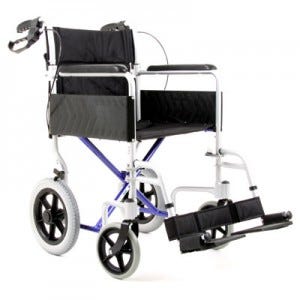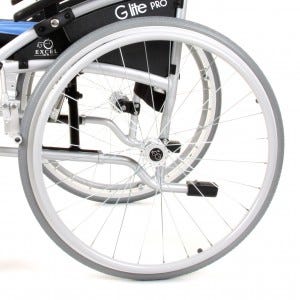There are many different models of wheelchair available on the market, whether you're after a compact travel chair, or are looking to get out and about by yourself with the assistance of a self-propelled model, wheelchairs are a popular way to stay mobile because of their small size and ease of use. However, much like other aids, due to the sheer amount of choice you'll also have to tackle the options available when it comes to tyres.
Today's blog outlines the different types manufactured and how each differs from the next. The type of tyre your wheelchair is fitted with is wholly dependent on the type and size of the chair. While travel wheelchairs come with smaller, solid wheels ideal for use indoors, larger chairs are designed for their versatility and robustness, able to tackle a range of terrains and inclines. Following are the definitions of each type of tyre, and how their benefits differ from each other.
Solid Tyres
 Solid tyres are typically constructed from rubber or plastic, are small in size and heavy in weight. Due to their solid design this type of tyre doesn't puncture and doesn't need re-inflating, saving you time when it comes to cleaning and maintaining your wheelchair. Plus, due to the smooth outer surface solid tyres are incredibly easy to manoeuvre, especially when the chair is used on level ground.
Solid tyres are typically constructed from rubber or plastic, are small in size and heavy in weight. Due to their solid design this type of tyre doesn't puncture and doesn't need re-inflating, saving you time when it comes to cleaning and maintaining your wheelchair. Plus, due to the smooth outer surface solid tyres are incredibly easy to manoeuvre, especially when the chair is used on level ground.
However, because of their construction solid tyres don't provide as smooth a ride compared to other types, as the rubber/plastic doesn't cushion the chair from lumps and bumps in the ground.
 Pneumatic Tyres
Pneumatic Tyres
Pneumatic tyres are normally included on larger, eases friction, providing better grip.
With that being said, pneumatic tyres require regular, thorough maintenance to ensure they're kept in a good condition. As they're filled with air they are liable to punctures that will need patching up, or the tyre may need replacing entirely. You'll also need to check the pressure of each tyre to ensure the level matches the figure printed on the surface of the rubber/in the user manual. However, aside from the upkeep pneumatic tyres provide a better quality of ride.
Puncture Proof Wheelchair Tyres
The third type of tyre available is the puncture proof. Fitted with an inner tube made of tough Kevlar, the design stops sharp objects (twigs, glass shards, stones) of up to 5mm from piercing the internal surface, keeping the tyre inflated and safe to use. However, because of the high-tech design and construction puncture proof tyres can be very expensive compared to other models available.
Pressure - Why's It Important? As stated above, if you decide to purchase a wheelchair fitted with pneumatic/air filled tyres you'll need to regularly check the pressure - but why's it important? If the air pressure inside is too low then you'll find that rolling resistance will be increased, meaning more effort from you will be needed to get the chair moving forwards. In contrast, if you inflate the tyres too much and the pressure is increased too far they can burst, so be careful! Always check the figure stated on the surface of the tyre/printed in your user manual.
Shop wheelchairs, or watch our wheelchair reviews.


 Price Match Promise
Price Match Promise
 Next day delivery, 7 days a week
Next day delivery, 7 days a week
 Nationwide Showrooms
Nationwide Showrooms
 Rated Excellent
Rated Excellent







